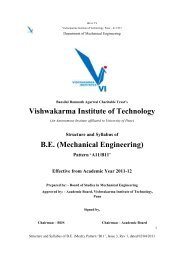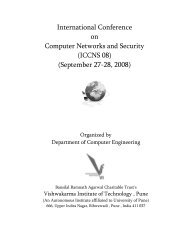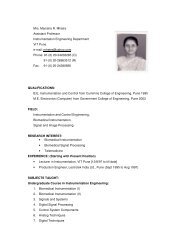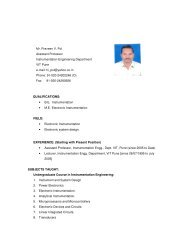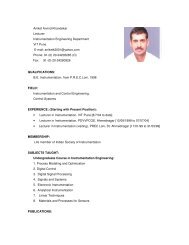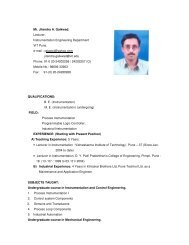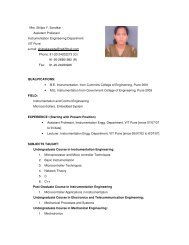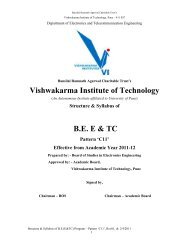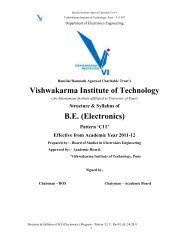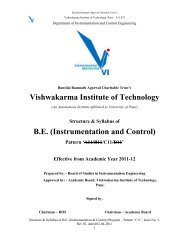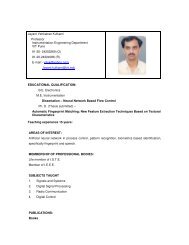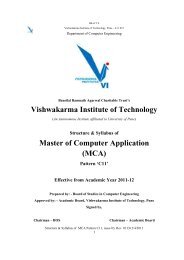EC0012 : Solid State Devices
EC0012 : Solid State Devices
EC0012 : Solid State Devices
You also want an ePaper? Increase the reach of your titles
YUMPU automatically turns print PDFs into web optimized ePapers that Google loves.
<strong>EC0012</strong> : <strong>Solid</strong> <strong>State</strong> <strong>Devices</strong><br />
Objectives:<br />
To understand<br />
• Semiconductor physics<br />
• Bipolar <strong>Devices</strong> viz. diode, BJT<br />
• Unipolar devices viz. JFET and MOSFET<br />
• Basic BJT configurations<br />
• Small signal analysis of semiconductor devices<br />
• Frequency response of an amplifier<br />
Unit 1 : Semiconductor Physics ( 7 Hrs )<br />
Intrinsic and extrinsic semiconductors, Conduction mechanism in extrinsic semiconductors,<br />
Carrier concentrations, Semiconductor equations and carrier statistics: Poisson's and<br />
continuity equation, Excess carriers, Recombination process, Conductivity, Mobility, Mass<br />
action law, Einstein relationship, Concept of band diagram (E-K and Energy vs distance)<br />
pertaining to semiconductor materials used in modern semiconductor devices.<br />
Unit 2 : Semiconductor Diode ( 6 Hrs )<br />
Open circuited step graded junction, Energy Band diagram of p-n junction, Metallurgical<br />
junctions and Ohmic contacts, Depletion region, Barrier potential, Forward and reverse<br />
biased diode operation, V-I characteristic equation of diode, Temperature dependence of V-I<br />
characteristics, Forward and reverse dynamic resistance, Small signal and large signal diode<br />
models, junction capacitances, Diode data sheet specifications.<br />
Unit 3 : Bipolar Junction Transistor ( 8 Hrs )<br />
BJT as a device, concept of amplification, BJT configurations, biasing BJT, DC analysis of<br />
BJT circuits, Typical junction voltages for cutoff, active and saturation regions, Voltage<br />
divider bias and its analysis for stability factors, Small signal-low frequency h-parameter<br />
model, Variation of h-parameters with operating point, Other small signal models, Single<br />
stage BJT amplifiers (CE, CB, CC), Analysis of CE configuration for ABVB, RBiB, RBOB, ABIB, ABVSB, ABISB<br />
in terms of h-parameters, Comparison of performance parameters with CB and CC<br />
configurations. Small signal and DC data sheet specifications for BJT. Power BJT<br />
construction, Data sheet specifications, Thermal resistance, Safe operating area (SOA)<br />
Unit 4 : Field Effect Transistor ( 7 Hrs )<br />
JFET construction, Symbol, Basic operation, V-I Characteristics, Transfer Characteristics<br />
(Shockley's Equation), Cut-off & Pinch-off voltages, Transconductance, Input resistance &<br />
Capacitance. Drain to Source resistance. Biasing of JFET - Biasing against device variation,<br />
biasing for zero current drift. JFET data sheet specifications. JFET as an amplifier, small<br />
signal JFET model, analysis of CS, CD, CG amplifiers using small signal JFET model.
Unit 5 : MOSFET ( 7 Hrs )<br />
MIS structures, two terminal structure: MOS capacitor, concept of accumulation, depletion<br />
and inversion; four terminal structure: MOSFET, its I-V characteristics, drain current<br />
equation in terms of W/L, second order effects, brief introduction to MOS scaling and scaling<br />
issues viz. short channel effects. Power MOSFET Construction, Comparison with power BJT<br />
Unit 6 : Frequency Response of Amplifiers ( 7Hrs )<br />
Concept of frequency response, Human ear response to audio frequencies, significance of<br />
Octaves and Decades. The decibel unit. Square wave testing of amplifiers, Miller's theorem.<br />
Effect of coupling, bypass, junction and stray capacitances on frequency response for BJT<br />
and FET amplifiers. Concept of dominant pole.<br />
Outcome:<br />
At the end of this course, students will be able to<br />
• Explain constructional details<br />
• Plot I-V characteristics of various semiconductor devices.<br />
• Classify basic amplifier configurations<br />
• Perform DC as well as AC analysis of amplifiers<br />
• Plot frequency response of amplifier<br />
Text Books<br />
1. Millman Halkias, Electronic Device & Circuits, Tata McGraw Hill<br />
2. Thomas L. Floyd, Electronic <strong>Devices</strong>, Pearson Education<br />
Reference Books<br />
1. B.G. Streetman, <strong>Solid</strong> <strong>State</strong> Electronic <strong>Devices</strong>, Prentice Hall of India, New Delhi.<br />
2. Millman Halkias, Integrated Electronics, Tata McGraw Hill<br />
3. Millman Grabel, Microelectronics, Tata McGraw Hill<br />
4. Thomas L. Floyd, Electronic <strong>Devices</strong>, Pearson Education
EC0022 : Communication Engineering<br />
Objectives: After studying this subject students will learn<br />
● Need of analog communication and advantages of digital communication<br />
● Necessity of modulation<br />
● Basic AM and FM circuits<br />
● Measurement of noise in communication system<br />
● Antenna fundamentals and Mechanism of wave propagation<br />
● Electronic and Cordless telephony<br />
Unit 1 : Introduction To Communication System ( 6 Hrs )<br />
Definition of communication, analog communication & digital communication,<br />
Communication System, Types of communications, Base band Communication – Merits,<br />
demerits, applications, Need for modulation, RF Spectrum and its use, Communication<br />
Channels<br />
Unit 2 : Amplitude Modulation ( 8 Hrs )<br />
AM concepts, Derivation of an AM equation, Modulation index, efficiency, power relations,<br />
Low level and high level AM transmitters, DSB-SC and SSB-SC AM – Need, circuits,<br />
merits, demerits, Frequency Division Multiplexing<br />
Unit 3 : Angle Modulation ( 7 Hrs )<br />
Basic principles of FM and PM, Mathematical representation, Modulation index and<br />
sidebands, Noise suppression effects of FM, FM generation methods, circuits, NBFM and<br />
WBFM, Comparison – AM, FM, PM<br />
Unit 4 : Communication Receivers ( 7 Hrs )<br />
Basic principles of signal reproduction, Super heterodyne Receivers, Frequency conversion,<br />
Intermediate frequency and image frequency, AM detectors – Simple diode detector,<br />
practical diode detector, DSBSC and SSBSC detectors, FM detectors – Phase discriminator,<br />
ratio-detector, Noise – Classification, expressing noise levels, noise in cascaded stages<br />
Unit 5 : Antennas and Wave Propagation ( 7 Hrs )<br />
Antenna Fundamentals –Radio waves, Antenna operation, Antenna Reciprocity, Basic<br />
Antenna; Common Antenna Types; Radio wave propagation – Optical characteristics of<br />
Radio Waves, propagation through space, calculating received power; Common propagation<br />
problems – Multipath fading, shadow fading, Rayleigh fading, remedies on these problems
Unit 6 : Telephone Communication ( 7 Hrs )<br />
Telephones – The local loop, Telephone set, Electronic Telephone – Electronic Telephone,<br />
Microprocessor control, voice mail, caller ID, Line interference, Digitally Enhanced Cordless<br />
Telephones – Concepts, frequency allocations, features, capabilities and limitations,<br />
Telephone System – Hierarchy, Private Telephone System, Internet Telephony<br />
Outcomes: Students will be able to<br />
● Build simple AM modulator, Low level AM Transmitter<br />
● Analyze AM and FM signals and their spectrums<br />
● Define and measure radio performance characteristics<br />
● Know latest technology of Electronics and cordless telephony<br />
Text Books<br />
1. Louis E Frenzel, ‘Principles of Electronic Communication Systems’, TMH<br />
Publication, Third Edition<br />
Ref Books<br />
1. Kennedy & Devis, ‘Electronic Communication’, TMH Publication<br />
2. Dennis Roddy & Coolen, ‘Electronic Communication’, PHI Publication
P<br />
and<br />
P<br />
Order<br />
P<br />
order<br />
EC0032: Feedback Control Systems<br />
Prerequisites :<br />
• Linear differential equations with constant coefficients.<br />
• Elementary matrix manipulations (such as determinant and inverse).<br />
• Adequate familiarity with computers. Familiar with software tool like MATLAB will<br />
be the added advantage<br />
Objectives:<br />
• Develop fundamentals associated with the analysis, design and simulation of feedback<br />
control systems for electronics students.<br />
Unit 1: Introduction to Control Systems ( 4 Hrs )<br />
Basic Concepts of control systems with examples: Open-loop and closed-loop systems.<br />
Representation of physical Systems-Electrical, Mechanical, F-V and F-I analogies,<br />
Electromechanical systems. Differential equations and Transfer functions<br />
Unit 2: Block diagram representation and analysis ( 4 Hrs )<br />
Block Diagram Algebra, Signal Flow graph, Conversion of Block Diagram to Signal Flow<br />
Graph, Conversion of Signal Flow Graph to Block Diagram<br />
Unit 3: Time Domain Analysis of Control Systems ( 6 Hrs )<br />
Introduction, Standard input signals like Impulse, Step, Ramp, and Sinusoidal. 1P<br />
nd<br />
system, 2P<br />
Porder system and their Response to impulse, step and ramp inputs. Time Domain<br />
st nd<br />
Specifications of 1P 2P Systems.<br />
st<br />
Unit 4: Pole zero plots and analysis ( 4 Hrs )<br />
Introduction, Pole-Zero Plots, Effects of Addition of Poles and Zeros on Stability, Hurwitz<br />
Criteria Routh Array<br />
Unit 5: Frequency Domain Analysis of Control Systems ( 5 Hrs )<br />
Introduction, Frequency Response and Frequency Domain Specifications, Correlation<br />
between Frequency and Time Domain Specifications,<br />
Unit 6: Frequency domain plots and stability analysis ( 5 Hrs )<br />
Bode Plot, Stability Analysis of systems. Introduction to Polar plot and Nyquist plot
Outcomes:<br />
Upon studying this subject the student will know the basic concepts of feedback control<br />
system<br />
Text Books<br />
Reference Books<br />
1. K. Ogata- Modern Control Engineering, Pearson education India, Fourth<br />
edition, 2002.<br />
2. B. C. Kuo- Automatic control systems, Prentice –Hall of India, Seventh<br />
Edition, 2000.<br />
1. Norman S. Nise- Control systems Engineering, John Wiley and sons.Inc,<br />
Third Edition, Singapore, 2001.<br />
2. R.C.Dorf and R.H. Bishop- Modern Control systems, Addison-Wesley, Eighth<br />
Edition, 1999.<br />
3. I. J. Nagrath and M. Gopal- Control systems Engineering, New age<br />
International Publishers, Third Edition, India, 2001.
CS4012 : Data Structures and Algorithm<br />
TPrerequisites:<br />
1. Basics of ‘ C’ Programming Language<br />
Objectives:<br />
• To study efficient algorithms for a number of fundamental problems<br />
• To study techniques for designing algorithms using appropriate data structures,<br />
• To understand the correctness of an algorithms<br />
• To design an algorithm<br />
• To calculate the time complexity and space complexity of an algorithm<br />
• To optimize the algorithms<br />
• To apply the algorithm to find the solution of given problem..<br />
• To create data structures depending on the application.<br />
Unit 1: Analysis of Algorithms and Fundamentals of Data Structures<br />
(6 Hrs)<br />
Analysis of algorithm, Performance Consideration, Time and Space Complexity, Asymptotic<br />
notation, Data Type, Data Object and Data Structure, Abstract Data Structure (ADT). Types<br />
of Data Structures, Searching and Sorting Techniques, Hashing<br />
Unit 2: Linear Data Structures<br />
(5 Hrs)<br />
Concept of sequential organization and Ordered List, Linear Data Structured using Linked<br />
organization: Dynamic Memory Management, Types of Linked List<br />
Concept of stack, stack as ADT , Representation of Stack using Array and Linked List<br />
Concept of queue, Queue as ADT, Representation of Queue using Array and Linked List<br />
Unit 3: Applications of Linear Data Structures<br />
(5 Hrs)<br />
Generalized Linked List, Polynomial Manipulations, Infix to Postfix Conversion and<br />
Evaluation, Validity of Parenthesis, Types of queue - Circular Queue, Priority Queue etc<br />
Unit 4: Non Linear Data Structures - Trees<br />
(4 Hrs)<br />
Basic Terminology of Trees, Concept of Binary Tree, Construction and Traversal of BT<br />
Concept of Binary Search Tree and Threaded Binary Tree,<br />
Unit 5: Non Linear Data Structures - Graphs<br />
(4 Hrs)<br />
Basic Terminology of Graphs, Types of Graphs, Graph Representation, Elementary Graph<br />
Operation and Graph Traversal<br />
Unit 6: Applications of Non Linear Data Structures<br />
(4 Hrs)<br />
Heap sort using Tree, OBST, Spanning Tree – Kruskal’s and Prim’s Algorithm<br />
Shortest path algorithm. – Dijksta’s Shortest Path Algorithm<br />
Outcomes
Students will be able to:<br />
• Identify the suitable algorithm for any given problem.<br />
• Explain the sorting and searching algorithms.<br />
• Apply the algorithm for any given problem.<br />
• Calculate the time and space complexity of the algorithm.<br />
• Determine whether the algorithm is better and able to give reasoning.<br />
• Optimize the given algorithm based on the time and space complexity.<br />
• Classify different data structures.<br />
• Create the data structure for any given problem.<br />
• Design different operations on the given data structures.<br />
Text books<br />
1. Tenenbaum A M & Langsam Y: Data Structure Using C. Prentice Hall Of India<br />
New Del, 1991<br />
2. Horowits E & Sahni S: Fundamentals Of Data Structures. Gurgaon. Galgotia<br />
Book Source New Delhi, 1983/1976<br />
Reference:<br />
1. Kruse R L, Leung B P & Tondo C L: Data Structure And Programming Design In C.<br />
Prentice Hall Of<br />
India Pvt.ltd, 1991<br />
2. Kakde O G & Deshpande ,” Data Structures And Algorithms”. Indian Society For<br />
Technical E, 2001<br />
3. Sahni S: Data Structures, Algorithms,& Applications In C++. Mcgraw Hill<br />
Boston, 1998
ES0142 : Engineering Mathematics –III<br />
Prerequisites: Engineering Mathematics I and Engineering Mathematics II.<br />
Objectives:<br />
• To achieve a fluency with Mathematical tools which is an essential weapon in modern<br />
Graduate Engineer’s Armory and the balance between the development of<br />
understanding and mastering of solution techniques with emphasis being on the<br />
development of student’s ability to use Mathematics with understanding to solve<br />
Engineering problems by retaining the philosophy of “learning by doing”.<br />
Unit-1. Linear Differential equations of higher order.<br />
(7 Hrs)<br />
Homogeneous Linear Equations of Second Order, Higher Order Homogeneous & Non<br />
Homogeneous Linear Differential Equations with Constant Coefficients, Solutions by<br />
undetermined coefficients and Variation Of Parameters method ,Euler – Cauchy Equation,<br />
Application of system of ordinary differential equations.<br />
Unit-2. Laplace and Z Transform<br />
(7 Hrs)<br />
Introduction and definition of Laplace Transform, Transforms of simple functions, basic<br />
properties of Laplace Transform, Inverse Laplace Transform and its evaluation. Laplace<br />
Transform of unit step function, impulse function & periodic functions, Applications to<br />
enggineering Problems. Introduction to Z Transform, properties of Z-Transform, Inverse Z-<br />
Transform, application of Z-transform to difference equations.<br />
Unit-3. The Fourier Transform<br />
(7 Hrs)<br />
Complex Fourier series and frequency spectrum ,Fourier integrals, Fourier Transform pair,<br />
The continuous Fourier spectra, properties of Fourier Transform, linearity, time difference,<br />
time shift, frequency shift and symmetry properties. The frequency response: relationship<br />
between Fourier Transform and Laplace Transform The frequency response, Transforms of<br />
the step and impulse function: Energy and power, convolution & application to Engineering<br />
problems.<br />
Unit-4. Vector Calculus<br />
(7 Hrs)<br />
Vector and scalar functions & fields, Derivative, Gradient of a scalar field, Directional<br />
derivative, Divergence and curl of a vector field, vector identities, Irrotational and solenoidal<br />
vectors and potential functions, line and surface integrals, Green’s, Stoke’s and Gauss<br />
theorems and applications to Engineering Problems.
P<br />
Edition),<br />
P<br />
Ed,2003.<br />
Unit-5. Numerical Methods<br />
(7 Hrs)<br />
Numerical solution of linear & nonlinear algebraic & transcendental equations. Integration by<br />
Trapazoidal and Simpson’s rules. Numerical solution of first order differential equations:<br />
Euler’s method, multistep methods, predictor corrector method and Runge-Kutta method.<br />
Numerical solution of second order differential equation.<br />
Unit -6. Probability and Statistics<br />
(7 Hrs)<br />
Probability and rules of probability, Random variables, Probability distributions, Mean and<br />
variance of distributions, Binomial, Poisson ,Hypergeometric and Normal distributions.<br />
Regression and correlation analysis.<br />
Outcomes:<br />
By the end of this module students are expected to demonstrate the knowledge of<br />
• Linear differential equations for modeling of a linear systems and its solutions by<br />
classical, transform techniques and numerical methods.<br />
• Solutions of difference equations by using Z-transforms.<br />
• Derivative , integration of vector function, gradient ,divergence and curl of a vector<br />
function. Its physical and geometrical interpretation with Gauss divergence , Stokes’<br />
theorem and its applications to electromagnetic theory.<br />
• Statistical distributions, regression and correlation analysis.<br />
TEXT BOOKS:<br />
1. Erwin Kreyszig, ‘Advanced Engineering Mathematics’, John Wiley and sons (8th Edition),<br />
inc., 2003.<br />
th<br />
2. Dr. B.S. Grewal, ‘Higher Engineering Mathematics’, Khanna Publishers, Delhi (38P<br />
P<br />
Edition), 2000.<br />
REFERENCE BOOKS:<br />
1. Murray R. Spiegel ‘Advanced Calculus’ by [Schaum’s out line series],1981.<br />
th<br />
2. Thomas, G. B. and Finney,’Calculus and analytic Geometry, Wesley/Narosa, (6P<br />
P<br />
Edition)<br />
1985.<br />
3. Dennis G. Zill and Michael R. Cullen, ‘Advanced Engineering Mathematics’, CBS New<br />
nd<br />
Delhi, (2P 2000.<br />
4. Michael D.Greenberg, ‘Advanced Engineering Mathematics’, Prentice Hall International,<br />
(second Edition), 1998.<br />
5. C. Ray Wylie, Louis C Barrett R, ‘Advanced Engineering Mathematics’, McGraw-Hill<br />
th<br />
Book Company, 6P
6. Pipes and Harvill, ‘Applied Mathematics for Engineers and Physicists’, McGraw-Hill<br />
Book Company, 3 rd Ed. 1984.<br />
7. Larry C., Andrews & Ronald L. Philips, ‘Mathematical Techniques for Engineers &<br />
scientists’, PHI Pvt. Ltd., New Delhi, Indian reprint by SPIE, 2005.<br />
8. Alan Jeffrey, ‘Advanced Engineering Mathematics’, Academic Press, 1 st Ed., 2002.<br />
9. M. K. Jain, S.R.K Iyengar & R .K. Jain, ‘Numerical Methods for scientific & engineering<br />
computations’, Wiley Eastern Ltd., (2 nd edition), New Delhi,1991.
RBEB and<br />
and<br />
and<br />
EC5012 : <strong>Solid</strong> <strong>State</strong> <strong>Devices</strong><br />
Objectives:<br />
Students should learn to verify experimentally<br />
• Transfer characteristics of device under study<br />
• Biasing of the device<br />
• Build and test amplifier circuit<br />
• Simulate amplifier circuit<br />
• Frequency response of an amplifier<br />
UList of Practicals<br />
1. Study of JFET drain and transfer characteristics.<br />
2. JFET biasing arrangement Graphical method.<br />
3. Build and Test JFET CS amplifier.<br />
Find performance parameters for JFET amplifier - ABVB, RBiB, RBOB.<br />
4. Simulation of JFET CS amplifier using multisim/spice.<br />
Find performance parameters for JFET amplifier - ABVB, RBiB, RBOB compare with<br />
theoretical and practical results.<br />
5. Input and Output Characteristics of BJT CE configuration. Find h parameters from<br />
characteristics.<br />
6. Build and Test BJT in CE amplifier and find performance parameters - ABVB, RBiB, RBOB, ABIB<br />
7. Simulation of BJT CE amplifier using multisim/spice<br />
Find performance parameters for BJT amplifier - ABVB, RBiB, RBOB, ABIB compare with<br />
theoretical and practical results.<br />
8. Comparison of CE, CC, CB configurations in terms of ABVB, RBiB, RBOB, ABIB.<br />
9. Study of MOSFET drain and transfer characteristics<br />
10. Frequency response - For BJT/ FET single stage amplifiers - Effect of unbypassed<br />
RBSB. Effect of coupling and bypass capacitors on low frequency cut-off.<br />
Outcome:<br />
At the end of this course, students will be able to verify experimentally<br />
• Transfer characteristics of device under study<br />
• Biasing of the device<br />
• Build and test amplifier circuit<br />
• Simulate amplifier circuit<br />
• Frequency response of an amplifier
Text Books<br />
1. Millman Halkias, Electronic Device & Circuits, Tata McGraw Hill<br />
2. Thomas L. Floyd, Electronic <strong>Devices</strong>, Pearson Education<br />
Reference Books<br />
1. B.G. Streetman, <strong>Solid</strong> <strong>State</strong> Electronic <strong>Devices</strong>, Prentice Hall of India, New Delhi.<br />
2. Millman Halkias, Integrated Electronics, Tata McGraw Hill<br />
3. Millman Grabel, Microelectronics, Tata McGraw Hill<br />
4. Thomas L. Floyd, Electronic <strong>Devices</strong>, Pearson Education<br />
5. Robert L. Boylestad, Louis Nashelsky, ‘Electronic <strong>Devices</strong> and Circuit Theory’ Prentice<br />
Hall Publication
EC5022: Communication Engineering<br />
Objectives:<br />
● To analyze different modulated signals in time domain and frequency domain<br />
● To understand bandwidth requirement, power, modulation index of AM and FM signals<br />
● To realize measurement of performance parameters of super heterodyne receiver<br />
● To know radiation pattern of yagi antenna<br />
● To simulate the performance of analog communication system in presence of noise in<br />
MATLAB environment<br />
UList of Practicals<br />
1. Fourier Analysis of signals such as sine wave, triangular wave, square wave using<br />
Digital Storage Oscilloscope (DSO)<br />
2. Generation and detection of DSB-FC (AM) signal<br />
3. Generation and detection of DSB-SC signal<br />
4. Generation and detection of SSB-SC signal<br />
5. IC Based FM Generation & demodulation using ratio-detector<br />
6. Measurement of receiver characteristics<br />
7. Measurement of radiation pattern for Yagi Antenna<br />
8. Design and implementation of analog communication system in presence of noise in<br />
MATLAB environment<br />
a. Use any one modulation technique from DSF-FC, DSB-SC, SSB, FM.<br />
b. For addition of noise Random noise, Gaussian noise, Rayleigh fading noise<br />
can be considered<br />
Outcomes:<br />
After the end of course, students will be able to<br />
i. Design and build AM and FM modulators<br />
ii. Measure selectivity, sensitivity and fidelity of radio receiver<br />
iii. Plot radiation pattern of any antenna<br />
iv. Implement a complete analog communication system in MATLAB<br />
Text Books<br />
1. Louis E Frenzel, ‘Principles of Electronic Communication Systems’, TMH<br />
Publication, Third Edition<br />
Ref Books<br />
1. Kennedy & Devis, ‘Electronic Communication’, TMH Publication<br />
2. Dennis Roddy & Coolen, ‘Electronic Communication’, PHI Publication
EC5032 : Feedback Control System<br />
Prerequisites :<br />
• Linear differential equations with constant coefficients.<br />
• Elementary matrix manipulations (such as determinant and inverse).<br />
• Adequate familiarity with computers. Familiar with software tool like MATLAB will<br />
be the added advantage<br />
Objectives:<br />
• Develop fundamentals associated with the analysis, design and simulation of feedback<br />
control systems for electronics students.<br />
UList of Practicals<br />
1. Detail study of any one of the following physical systems<br />
a. Temperature control systems<br />
b. Pressure control systems<br />
c. Flow control systems<br />
d. Level control systems<br />
2. Obtain step and impulse response of Level system. Find the time constant of the level<br />
system<br />
3. Obtain step and impulse response of R-C/R-L system<br />
4. Obtain the transfer function and of time domain specifications of R-L-C network and<br />
Investigate stability by Hurwitz criteria<br />
5. Investigate stability of second/third order system by Routh criteria<br />
6. Obtain gain margin and phase margin and correspond frequencies of second/third<br />
order system<br />
7. Investigate stability of given(Instructor will provide the appropriate model to<br />
students) system using Bode<br />
Outcomes:<br />
Upon studying this subject the student will know the basic concepts of feedback control<br />
system
Text Books<br />
1. K. Ogata- Modern Control Engineering, Pearson education India, Fourth<br />
edition, 2002.<br />
2. B. C. Kuo- Automatic control systems, Prentice –Hall of India, Seventh<br />
Edition, 2000.<br />
Reference Books<br />
1. Norman S. Nise- Control systems Engineering, John Wiley and sons.Inc, Third<br />
Edition, Singapore, 2001.<br />
2. R.C.Dorf and R.H. Bishop- Modern Control systems, Addison-Wesley, Eighth<br />
edition, 1999.<br />
3. I. J. Nagrath and M. Gopal- Control systems Engineering, New age<br />
International Publishers, Third Edition, India, 2001
IC5902: Electronic Instrumentation and Measurements<br />
Objectives: To provide adequate concepts in<br />
• Measurement Errors<br />
• Basic Instruments<br />
• Different Probes<br />
• Methods of Measurement<br />
• Advancement in Measurement<br />
Unit 1 : Introduction To Basics ( 3 Hrs )<br />
Introduction to electronic instrumentation and measurements, types of instruments, classification of<br />
instruments, basic definitions, Error Analysis, Units of Measurements, Statistical Analysis<br />
Unit 2 : Requirements For Actual Measurement ( 2 Hrs )<br />
Types of Transducers, Sensors & their Applications, Signal Conditioning Circuits, Types of Probes<br />
and Connectors<br />
Unit 3 : Measurements ( 5 Hrs )<br />
Methods of measurement, Direct / Indirect Methods, Bridges, Resonance Methods, Current<br />
measurement<br />
Peak to Peak, rms and average Voltage Measurements, TRMS meter, Time measurements, Frequency<br />
measurements<br />
Unit 4 : Components Measurement ( 1 Hr )<br />
L /C / R - Q Measurement<br />
Unit 5 : Oscilloscope ( 2 Hrs )<br />
Cathode Ray Oscilloscope, Digital Storage Oscilloscope<br />
Unit 6 : Advancement In Measurement ( 1 Hrs )<br />
Automation of Instruments, Digital Instruments
Outcomes:<br />
After successful completion of the course students will be able to<br />
• Measure different parameters<br />
• Compare the instruments and select proper instrument for the application<br />
• Calculate the errors in Measurement<br />
• Design basic measurement system<br />
Text Books<br />
1. Oliver Cage, “Electric Instrumentation”, Tata McGraw Hill.<br />
2. J. J. Carr, “Digital Instrumentation”<br />
Reference Books<br />
1. H.S. Kalsi, “Digital Instrumentation”, Tata McGraw Hill.<br />
2. Coombs, “Electronic Instrumentation Handbook”.<br />
3. A. J. Bowons, “Digital Communication”.<br />
4. Cooper Helfric, “Electric Instrumentation & Measurement Techniques”, Prentice Hall<br />
5. M. M. S. Anand, “Electric Instrument & Instrumentation Techniques”
IC5902: Electronic Instrumentation and Measurements<br />
Objective:<br />
To introduce all basic measuring instruments with front panel controls.<br />
List of Practicals<br />
1. Voltage, current and resistance measurement using multimeters, component testing<br />
using multimeters<br />
2. Observe & measure voltage by voltage source and waveforms by function generator<br />
on CRO<br />
3. High frequency measurement using DSO, storing and retrieving of results of<br />
mathematical operations on DSO<br />
4. Quality factor measurement of inductor and capacitor using LCR-Q meter<br />
5. Measurement of THD using distortion factor meter<br />
6. Measurement by higher and lower range DMMs and compare accuracy<br />
7. Time measurement, frequency measurement, ratio measurement using frequency<br />
counter<br />
8. Observe spectrum of sine, square and triangular waveform using spectrum analyzer<br />
9. Capture RLC transient using DSO.<br />
10. Measurement of radio receiver parameters.<br />
Outcome:<br />
After successful completion of the course students will be able to select proper instrument for<br />
measurement and compare the same with measurement by another instrument.<br />
Text Books<br />
1. Oliver Cage, “Electric Instrumentation”, Tata McGraw Hill.<br />
2. J. J. Carr, “Digital Instrumentation”<br />
Reference Books:<br />
Manuals of all the instruments
CS9012: Data Structures and Algorithm<br />
Objectives:<br />
• Learn techniques for implementing algorithms using appropriate data structures.<br />
List of Practicals<br />
1. Implement the following searching algorithms<br />
i. Binary Search<br />
ii. Linear search<br />
2. Implement the following sorting algorithms<br />
i. Bubble Sort<br />
ii. Insertion Sort<br />
iii. Quick Sort<br />
iv. Merge Sort.<br />
3. Create and manipulate database using structures.<br />
4. Create and manipulate database using Singly Linked List<br />
5. Implement<br />
i. Doubly Linked List<br />
ii. Circular Linked List<br />
6. Implement Stack<br />
i. using array and<br />
ii. linked list<br />
7. Implement Queue<br />
i. using array and<br />
ii. linked list<br />
8. Write a program to add two polynomials<br />
9. Write a program to convert expression in infix form to postfix form<br />
10. Write a program to create binary tree and perform operations on it.<br />
11. Write a program to create graph using adjacency list/matrix<br />
12. Write a program to find shortest path using Dijkstra’s Algorithm<br />
Comment: Use C programming language.<br />
Outcome:<br />
Students should be able to<br />
• Implement an algorithm and data structure.<br />
• Development of good and efficient programming skills.
Text books<br />
1. Tenenbaum A M & Langsam Y: Data Structure Using C. Prentice Hall Of India<br />
New Del, 1991<br />
2. Horowits E & Sahni S: Fundamentals Of Data Structures. Gurgaon. Galgotia<br />
Book Source New Delhi, 1983/1976<br />
Reference:<br />
1. Kruse R L, Leung B P & Tondo C L: Data Structure And Programming Design In C. Prentice<br />
Hall Of<br />
India Pvt.ltd, 1991<br />
2. Kakde O G & Deshpande ,” Data Structures And Algorithms”. Indian Society For<br />
Technical E, 2001<br />
3. Sahni S: Data Structures, Algorithms,& Applications In C++. Mcgraw Hill Boston, 1998
EC0042 : Signals and Systems<br />
Prerequisites:.<br />
Calculus and Complex numbers.<br />
Objectives:<br />
In this subject students will learn<br />
● Continuous-time and discrete-time concepts in an unified way<br />
● Operations on signals which forms the conception about different topics to be covered in<br />
future subjects related to signal processing<br />
● Significance of LTI systems and its analysis<br />
● Fourier series representation of different signals and its applications<br />
● How to solve complicated differential equations using Laplace Transform and its use in<br />
analysis of LTI system<br />
● Concept of correlation, implication of ESD and PSD<br />
● Use of random variables to solve problems on probability and random signals<br />
Unit 1 : Introduction To Signals And Systems ( 7 Hrs )<br />
Definition and classification of signals, Test signals – Sine, unit step, unit ramp, unit impulse,<br />
exponential, Signal operations – Operations performed on dependent and independent<br />
variables, Definition and classification of systems<br />
Unit 2 : Linear Time-Invariant Systems ( 7 Hrs )<br />
Introduction to LTI systems, Discrete-time LTI systems – The Convolution sum, Continuoustime<br />
LTI systems – The Convolution integral, Properties of LTI systems – Commutative,<br />
Distributive, Associative; Invertibility, Causality, Stability of LTI system, LTI system with<br />
and without memory<br />
Unit 3 : Fourier Analysis of Signals ( 7 Hrs )<br />
Conception of Fourier Series and Fourier Transform, Response of LTI systems to Complex<br />
Exponentials, Fourier series representation of Continuous-Time and Discrete-Time Periodic<br />
Signals, Fourier Series and LTI systems, LTI systems as frequency selective and frequency<br />
shaping filters, Fourier series representation of Continuous-Time and Discrete-Time Periodic<br />
Signals
Unit 4 : Laplace Transform ( 7 Hrs )<br />
Introduction and need, Definition – Unilateral and Bi lateral Laplace Transform, The Region<br />
of convergence, The Inverse Laplace Transform, Properties of the Laplace Transform,<br />
Analysis and characterization of LTI system using Laplace Transform<br />
Unit 5 : Correlation, Energy Spectral Density And Power Spectral Density ( 7 Hrs )<br />
Correlation and Correlogram, The Correlation Function, Autocorrelation – Properties,<br />
Examples and Applications, Cross correlation – Properties, Examples and Applications,<br />
Correlation and Fourier Series, Energy Spectral Density – Concept, Relation with<br />
Autocorrelation, Power Spectral Density – Concept, Relation with Autocorrelation<br />
Unit 6 : Probability and Random Variables ( 7 Hrs )<br />
Probability Theory – Sample space, events, definition of probability, conditional probability,<br />
statistical independence, Random variables – conception, continuous and discrete random<br />
variable, Cumulative Distributive Function, Probability Density Function & their properties,<br />
Transformation of random variables, statistical averages, mean, moments, expectations,<br />
standard deviation, variance, Probability Models – Binomial, Gaussian, Uniform, Poisson,<br />
Rayleigh, Random Process, Ergodic and stationary process<br />
Outcomes:<br />
After studying the syllabus, students will be able to<br />
• Classify various signals and systems<br />
• Analyze LTI systems<br />
• Analyze various signals in frequency domain using various transforms<br />
Text Books<br />
1. Haykin Simon & Veen Barry Van, ‘Signals And Systems’ New York. John Wiley &<br />
Sons, Inc, 1999Simon Hykin,Signals and Systems<br />
2. Roberts Michael J, ‘Signals and Systems’ New Delhi. Tata McGraw Hill Publishing<br />
Company Limited, 2003.<br />
Reference Books<br />
1. Oppenheim Alan V, Willsky Alan S & Nawab Hamid: Signals And Systems. (2) New<br />
Delhi. Prentice Hall Of India, 2004<br />
2. Nagrath I J, Sharan S N, Ranjan R & Kumar S: Signals And Systems. New Delhi.<br />
Tata Mc Graw Hill Publishing, 2001
List of Tutorials<br />
1. Study characteristics & features of following signals in continuous time(CT) &<br />
discrete<br />
time (DT) domain: impulse, step, ramp , sine, cosine, exponential.<br />
Characteristics & features : periodic / non periodic, even / odd symmetric, random<br />
/deterministic, energy / power, real / complex etc<br />
.<br />
2. Simple signal processing operations: sum, product, difference, scaling, even / odd,<br />
time<br />
shifting & time scaling, differentiation & integration<br />
3. Study various types of systems in CT / DT domains on the basis of linearity / non<br />
linearity, time in variance, memory, stability, causality etc.<br />
4. Study of characteristics of systems in terms of input -output relationship, convolution<br />
integral/sum, differential / difference equation.<br />
5. Fourier transform evaluation for following signals : i) Gate function (rectangular<br />
pulse) ii) Gaussian function. Draw amplitude & phase spectrum<br />
6. To verify properties of Fourier transform such as : i) Scaling ii) Symmetry iii)<br />
Modulation iv) Time shifting<br />
7. a) Analysis of typical signals using Laplace transform<br />
b) Solution of typical differential equations using Laplace transform (with initial<br />
conditions)<br />
8. Advanced signal processing operations : i. Auto-correlation and cross correlation ii.<br />
Covariance iii. Energy and Power spectral density<br />
Outcomes: At the end of this course, students will be able to<br />
1. Classify various signals and systems<br />
2. Analyze LTI systems<br />
3. Analyze various signals in frequency domain using various transforms<br />
Text Books<br />
1. Haykin Simon & Veen Barry Van: Signals And Systems. New York. John Wiley &<br />
Sons, Inc, 1999Simon Hykin,Signals and Systems<br />
2. M. J. Roberts Signals and Systems<br />
Reference Books<br />
1. Oppenheim Alan V, Willsky Alan S & Nawab Hamid: Signals And Systems. (2)<br />
New<br />
Delhi. Prentice Hall Of India, 2004
and<br />
EC0052: Electronic Circuits Analysis<br />
Objectives:<br />
To understand<br />
• Diode applications<br />
• Small signal multistage BJT amplifiers<br />
• Concept of Feedback and Oscillator<br />
• High frequency BJT analysis<br />
• Large Signal BJT amplifier<br />
• Voltage regulators<br />
Unit 1 : Diode Applications ( 7 Hrs )<br />
Diode Rectifiers : Half wave, full wave, Bridge Rectifiers, Output Waveforms, definitions<br />
and derivations of various parameters like RF, Average DC current, efficiency, TUF.<br />
Clipping and Clamping circuits : Series and parallel forms of clipping circuits, , their<br />
operation and transfer characteristics. Clamping circuits.<br />
Voltage multiplier circuits: Working and comparison of voltage doubler, tripler and voltage<br />
quadrapler configurations. Limitations of voltage multiplier circuits. Effect of frequency on<br />
load regulation.<br />
Unit 2 : Small signal Multistage BJT Amplifiers ( 7 Hrs )<br />
Need for multistage amplifiers and suitability of CE, CC and CB configurations in multistage<br />
amplifiers, Analysis of cascade and cascode connections, N stage cascade amplifier, band<br />
pass of cascaded stages (effect on frequency response), Concept of GBW.<br />
Unit 3 : Feedback Amplifiers and Oscillators ( 8 Hrs )<br />
Concept of feedback, Negative feedback, Four Feedback topologies, Transfer gain with<br />
feedback, Advantages and disadvantages of negative feedback, Effect of feedback on input<br />
and output impedances and bandwidth of an amplifier. Analysis of one circuit for each<br />
feedback topology. OSCILLATORS : Positive feedback, Oscillator startup mechanism, need<br />
for amplitude limiting. Study of LC oscillators - General form of LC oscillator. Hartley<br />
oscillator, Colpitts oscillator, Clapp oscillator. Crystal oscillator.<br />
Unit 4 : High frequency, small signal BJT amplifiers ( 7 Hrs )<br />
Behavior of transistor at high frequencies, High frequency hybrid π CE amplifier model, CE<br />
short circuit current gain, Definitions and derivations for fBαB, fBβB fBTB, Amplifier bandwidth<br />
taking into account source and load resistances, Techniques to improve bandwidth. Single<br />
tuned, Double tuned and stagger tuned amplifiers, Unloaded and loaded Q. Effect of<br />
staggering on bandwidth.
Unit 5 : Large Signal AF BJT Amplifiers ( 6 Hrs )<br />
Classes of power amplifiers - Class A, Class B, Class AB, class C, class D. Class A with<br />
resistive load, Transformer coupled class A amplifier, Class B Push-pull, Class AB,<br />
Complementary symmetry and Quasi-complementary configurations. Efficiency analysis for<br />
all, Comparison of efficiencies, Distortions in amplifiers, concept of Total Harmonic<br />
Distortion (THD).<br />
Unit 6 : Linear voltage regulators and voltage references ( 7 Hrs )<br />
Block schematic of linear regulators. Emitter follower regulator, Transistor series regulator<br />
and its analysis for performance parameters. 3 terminal floating, dual and adjustable<br />
regulators. Method of boosting output current using external series pass transistor.<br />
Performance parameters - Load and Line regulation, Ripple rejection, Output resistance and<br />
efficiency. Protection circuits - Reverse polarity protection, over current, fold back current<br />
limiting, over voltage protections. Important data sheet specifications of linear regulators.<br />
Voltage references, their peculiarities and applications.<br />
Outcomes:<br />
At the end of this course, students will be able to analyze<br />
• Diode circuits<br />
• Small signal and large signal BJT amplifier circuits<br />
• Voltage regulator circuits<br />
Text Books :<br />
1. Millman Halkias , Integrated Electronics , Tata McGraw Hill1.<br />
2. Millman Halkias ,Electronic Device & Circuits , Tata McGraw Hill<br />
Reference Books:<br />
1. Donald A. Neamen , Electronic circuit analysis & Design , Tata McGraw Hill<br />
2. B.G. Streetman, <strong>Solid</strong> <strong>State</strong> Electronic <strong>Devices</strong>, Prentice Hall of India, New Delhi.<br />
3. Millman Grabel , Microelectronics ,Tata McGraw Hill<br />
4. Thomas L. Floyd ,Electronic <strong>Devices</strong> ,Pearson Education<br />
5. Chryssis , Switched mode power supplies
EC0062: Digital Electronics & Microprocessors<br />
Objectives:<br />
To introduce<br />
• Basics of digital circuits using building blocks such as gates and flip-flops<br />
• Design of different combinational and sequential circuits and their applications<br />
• Principles of basic Microprocessor System<br />
Unit 1 : NUMBER SYSTEMS AND CODES ( 4 Hrs )<br />
Decimal, Binary, Hexadecimal, and Octal number systems; Inter conversions,<br />
compliments; Addition and Subtraction using 1’s and 2’s complements; Binary Codes, Gray<br />
Code, Excess-3 Code.<br />
Unit 2 : BOOLEAN LOGIC ( 6 Hrs )<br />
Standard logic gates, Universal logic gates, Derived gates (symbol, equation and truth table)<br />
Boolean Algebra: Basic Boolean functions, Postulates and theorems of Boolean Algebra,<br />
Sum-of-Products and Product-of-Sums forms of Boolean functions; Canonical and Standard<br />
forms. NAND and NOR implementation; Simplification of Boolean Functions, POS and SOP<br />
simplification, K map up to 4 variables, Design example - Code converter.<br />
Unit 3 : COMBINATIONAL LOGIC & MEMORY ELEMENTS ( 8 Hrs )<br />
Design procedure for combinational logic circuits; design and analysis of Half Adder, Full<br />
Adder, Analysis & Design of Encoders and Decoders; Multiplexer and demultiplexers, their<br />
use in designing combinational circuits. Parity generator, Parity checker, Comparator.<br />
Memory Elements : - SR, JK, T, D Flip-flops and Latches, schematic symbols, truth table and<br />
Excitation Table; Triggering of Flip-flops.<br />
Unit 4 : SEQUENTIAL LOGIC ( 10 Hrs )<br />
Mealy, Moore machines, Design procedure for sequential circuits using state diagrams, <strong>State</strong><br />
Tables, <strong>State</strong> assignments and <strong>State</strong> minimization methods, Circuit implementation. Design<br />
and analysis of Asynchronous and Synchronous Counters, Modulo Counters, Johnson and<br />
Ring Counters, Application of Counters. Counter ICs. Shift Registers: SISO, SIPO, PISO,<br />
PIPO, Bi-directional Shift Registers<br />
Unit 5 : BASIC MICROCOMPUTER SYSTEM ( 6 Hrs )<br />
Introduction to Microcomputer System, and 8 - bit Microprocessor Architecture,<br />
16 - bit Microprocessor Architecture, Bus Interface Unit, Execution Unit, Memory<br />
Organization, Bus operation, Input/Output.<br />
Unit 6 : INSTRUCTION FORMATS AND CLASSIFICATION ( 8 Hrs )<br />
Machine language Instruction Formats, Addressing Modes, Instruction Set - Data Transfer<br />
operations, Arithmetic Operations, Logical operations, String operations, Branching<br />
Operations, Flag manipulation and Processor control, Typical execution of an Instruction.<br />
Programs to perform ALU operation and code conversion.
P<br />
Edition<br />
P<br />
Edition<br />
Outcomes:<br />
After successful completion of the course students will be able to<br />
• Design digital circuits for register and counter<br />
• Draw state diagram<br />
• Explain the architecture of microprocessor<br />
Text Books<br />
1. Donald P Leach, Albert P Malvino, Goutam Saha, ‘Digital Principles and<br />
Applications’ (TMGH), 6th Edition<br />
nd<br />
2. Douglas Hall, ‘Microprocessor and Interfacing’ –, 2P (MGH)<br />
Reference Books<br />
rd<br />
1. M. Morris Mano, Digial Design - 3P (Pearson)<br />
2. Digital Systems :Principles and Applications – Ronald J Tocci, Neal S<br />
Widmer, 8th Edition ( PHI- EEE)<br />
th<br />
3. Charles H Roth, Jr., Fundamentals of Logic Design –(Thomson),5P<br />
P<br />
Edition,
ES0332 : Network Analysis & Synthesis<br />
Objectives:<br />
• To study Two-port Networks, its functions and parameters<br />
• To study system behavior using Pole zero plot<br />
• To understand and implement Filter approximations<br />
• To study variety of impedances and attenuators<br />
• To study the concept of resonance<br />
Unit 1: 2 Port Networks ( 6 Hrs )<br />
2 Port Network parameters, Z, Y h, T parameters and their inter relation, Interconnection of<br />
2 port networks.<br />
Unit 2 : Network functions ( 6 Hrs )<br />
Network functions for 1 port & 2 port networks, system function & it’s significance<br />
Unit 3 : Pole Zero plot & frequency domain behavior ( 6 Hrs )<br />
Significance of poles & zeroes, time domain behavior from poles and zeroes, residue<br />
locations & its significance in transfer function.<br />
Unit 4 : Filter approximation & synthesis ( 10 Hrs )<br />
Butterworth approximation, Chebyshev approximation, Butterworth low pass filter,<br />
butterworth high pass filter using RC-CR transformation, frequency scaling, Chebyshev low<br />
pass filter, realization using Sallen & key configurations .<br />
Unit 5 : Four terminal Network ( 7 Hrs )<br />
Symmetrical network, asymmetrical network , balanced & unbalanced network, characteristic<br />
impedance, propagation constant, iterative impedance, image impedance.<br />
Attenuators – T type, π type, bridge, ladder etc. Study of range selector switch in an<br />
electronic instrument such as – DMM, function generator, frequency counter, Q-meter etc<br />
Unit 6 : Resonance ( 7 Hrs )<br />
Resonance: Quality factor Q, Series resonance - bandwidth, impedance, selectivity; parallel<br />
resonance - bandwidth, impedance, selectivity .
6P<br />
P<br />
edition.<br />
Outcomes:<br />
After completion of this course students will be able to<br />
• Find Impedance and Admittance parameters of two port network .<br />
• Draw the pole zero plot of network functions<br />
• Apply the concept of Synthesis of two port network.<br />
• Apply the filter approximations to design an analog filter<br />
• Explain the working of range selection switch (based on attenuators) for standard<br />
electronic instruments such as DMM, DC power supply, frequency generator etc.<br />
Text Books:<br />
1. Kimmerly, Hayt, ‘Electrical Circuit Analysis’, McGraw Hill Engineering Durbin –<br />
th<br />
2. Van Valkenberg, Analog Filter Design, Oxford Publishing<br />
Reference Books :<br />
1. A.K.Atre,Network Theory and Filter Design, Willey Eastern New Delhi.<br />
2. D. Roy Choudhary, Network and Systems, Willey Eastern New Delhi.
ES0222 : Electrical Circuits and Machines<br />
Prerequisites : Basic Electrical Engineering course at First year.<br />
Objectives:<br />
• To introduce single phase and three phase supply concepts<br />
• To introduce transformer action<br />
To introduce to basic concepts of power quality.<br />
• To make students aware of dc and ac motors characteristic.<br />
Unit I: Electrical power and its measurement<br />
7 Hrs<br />
Instantaneous power, active power, reactive power, apparent power, power factor,<br />
Measurement and Calculation of active, reactive power, pf in 3 phase balanced circuits using<br />
three watt meters, one Wattmeter and two watt meter methods. Measurement of power using<br />
CT and PT.<br />
Unit II: DC Machines:<br />
7 Hrs<br />
DC generators- Construction and working principle, commutator, EMF equation<br />
DC motors- Operation, types, losses and basic equations of DC motor. Torque equation,<br />
motor characteristics, speed control methods (descriptive treatment only), DC Motor starters,<br />
Applications.<br />
Unit III: Transformers:<br />
7 Hrs<br />
Single-phase transformers- Ideal & Practical Transformers, Equivalent circuit, Determination<br />
of transformer parameters (OC and SC tests), Efficiency and regulation of transformer.<br />
Special transformers: Auto transformer, Ferrite core transformers, phase shift transformer.<br />
Unit IV: Induction motors and Stepper motors.<br />
7 Hrs<br />
Three phase Induction Motors- Construction, operation, types, slip and torque equations, max<br />
torque, starting torque, full load torque, condition for max torque, torque-slip characteristics.<br />
1 phase Induction motors and Stepper motors.<br />
Outcomes: At the end of this course, students will be able to<br />
• Explain routine technical problems relating to the electrical power supply.<br />
• Analyze power supply quality.<br />
• Explain basic characteristics and operation of DC and AC motor.
Text Books:<br />
1. Guru, Hiziroglu - Electric Machinery & Transformers, Oxford University Press.<br />
2. H. Cotton - Electrical Technology.<br />
3. Electrical technology – Edward Hughes.<br />
4. Electrical technology – B. L. Theraja Vol- 1 and 2.<br />
Reference Books :<br />
1. Fitzgerald - Electric Machinery, TMH (Sixth Edition).<br />
2. Theodore Wildi - Electrical Machines, Drives & Power systems, Pearson Education.<br />
3. Nagrath Kothari - Electric Machines, TMH.<br />
4. Irving Kosow - Electrical Machines and transformers.
EC5052 : Electronic Circuits Analysis<br />
Objectives:<br />
Students should learn to verify experimentally<br />
• Transfer characteristics of circuits under study<br />
• Input and output waveforms<br />
• Characteristics of various feedback circuits<br />
• Efficiency of power amplifiers<br />
• Performance parameters of regulators<br />
1. Clipping and clamping circuits<br />
UList of Practicals<br />
2. Voltage multiplier circuits - Regulation characteristics and effect of frequency<br />
3. Build and Test BJT cascade amplifier and find performance parameters.<br />
4. Voltage-series amplifier<br />
5. Current-series feedback amplifier<br />
6. Voltage-shunt amplifier<br />
7. Current-shunt feedback amplifier<br />
8. Simulation of BJT LC oscillator<br />
9. Class A series fed and Class B push-pull amplifier - Efficiency calculations<br />
10. Study of single tuned amplifier<br />
Outcomes:<br />
At the end of the course students would be able to do practical analysis of the circuits under<br />
study in terms of their<br />
• Transfer characteristics<br />
• Input and output waveforms<br />
• Gain<br />
• Efficiency<br />
• Performance parameters etc.
Text Books<br />
1. Millman Halkias - Integrated Electronics - Tata McGraw Hill1.<br />
2. Millman Halkias - Electronic Device & Circuits - Tata McGraw Hill<br />
Reference Books<br />
1. Donald A. Neamen - Electronic circuit analysis & Design - Tata McGraw Hill<br />
2. B.G. Streetman, <strong>Solid</strong> <strong>State</strong> Electronic <strong>Devices</strong>, Prentice Hall of India, New Delhi.<br />
3. Millman Grabel - Microelectronics - Tata McGraw Hill<br />
4. Thomas L. Floyd - Electronic <strong>Devices</strong> - Pearson Education<br />
5. Chryssis - Switched mode power supplies
EC5062: Digital Electronics and Microprocessors<br />
Objectives:<br />
To introduce practical implementation of the combinational & sequential circuits.<br />
List of Practicals<br />
1. Code Conversion using logic gates<br />
2. Design & implement 2 bit comparator<br />
3. Design & implement BCD Adder using IC 7483<br />
4. Design & implement combinational logic circuit using multiplexer & demultiplexer<br />
5. Design & Implement 3 bit bidirectional shift register using flip-flop<br />
6. Design & implement pulse train generator using IC 7495<br />
7. Design & implement 3 bit up-down ripple counter using flip-flop<br />
8. Verification of mod-n counters using IC 7490 & IC 74191<br />
9. Design & implement sequence generator / detector using MS JK flip-flop<br />
Outcomes:<br />
TTL – CMOS Interfacing<br />
After successful completion of this lab course students will be able to design the<br />
combinational and / or sequential circuit with proper ICs.<br />
Text Books<br />
1. Digital Principles and Applications – Donald P Leach, Albert P Malvino, Goutam<br />
Saha, 6th Edition (TMGH)<br />
2. Microprocessor and Interfacing – Douglas Hall, 2 nd Edition (MGH)<br />
Reference Books<br />
1. Digial Design - M. Morris Mano, 3 rd Edition (Pearson)<br />
2. Digital Systems :Principles and Applications – Ronald J Tocci, Neal S Widmer,<br />
8th Edition (EEE – PHI)<br />
3. Fundamentals of Logic Design – Charles H Roth, Jr., 5 th Edition, (Thomson)
ES5222: Electrical Circuits and Machines<br />
Objectives:<br />
• To introduce single phase and three phase supply concepts<br />
• To introduce transformer action<br />
To introduce to basic concepts of power quality.<br />
• To make students aware of dc and ac motors characteristic.<br />
List of Experiments<br />
1. Speed control of DC Shunt motor.<br />
2. Load test on DC Shunt motor.<br />
3. Load test on DC Series motor.<br />
4. Power measurement in 3-phase circuit by two-wattmeter method.<br />
5. Reactive power measurement in 3-phase circuit by one-wattmeter method.<br />
6. O.C. & S.C. test on single-phase transformer.<br />
7. Load test on 3-phase Induction motor.<br />
8. Control of stepper motor.<br />
9. Control of servo motor.<br />
10. V/f control of Induction motor.<br />
11. Design and assembly of a 1 ph transformer.<br />
12. Study of HT and LT billing and Tariff.<br />
Outcomes: At the end of this course, students will be able to<br />
• Explain routine technical problems relating to the electrical power supply.<br />
• Analyze power supply quality.<br />
• Explain basic characteristics and operation of DC and AC motor.<br />
Text Books:<br />
1. Guru, Hiziroglu - Electric Machinery & Transformers, Oxford University Press.<br />
2. H. Cotton - Electrical Technology.<br />
3. Electrical technology – Edward Hughes.<br />
4. Electrical technology – B. L. Theraja Vol- 1 and 2.<br />
Reference Books :<br />
1. Fitzgerald - Electric Machinery, TMH (Sixth Edition).<br />
2. Theodore Wildi - Electrical Machines, Drives & Power systems, Pearson Education.<br />
3. Nagrath Kothari - Electric Machines, TMH.<br />
4. Irving Kosow - Electrical Machines and transformers.
CS9022: Electronic Software Workshop<br />
Prerequisite:<br />
Basics of programming language.<br />
Objective:<br />
• To study various software skills<br />
• To perform simulation of electronic circuits.<br />
• To interpret the output from the simulation.<br />
• To design the PCB.<br />
• To design GUI for the application/project work.<br />
UList of Practicals<br />
1. Introduction to simulation packages such as MATLAB.<br />
2. Solving linear and nonlinear equations.<br />
3. Solving linear and nonlinear.<br />
4. Interpolation and curve fitting algorithm.<br />
5. Integration and differentiation methods.<br />
6. GUI using simulation packages such as MATLAB.<br />
7. Simulating an electronics system using simulation package such as SIMULINK<br />
8. Simulating an electronics system using simulation package such as Multisim.<br />
9. PCB layout and design.<br />
10. Introduction to Visual C ++(For GUI development)<br />
11. Application development using VC++.<br />
12. Application development using VC++.
Outcome:<br />
Student will be able to<br />
• List the simulating software.<br />
• Identify the MATLAB’s toolkits.<br />
• Explain the the role of each MATLAB toolkits.<br />
• Distinguish between SIMULINK and MATLAB script.<br />
• Apply SIMULINK to simulate electronic circuits.<br />
• Apply Multisim to simulate the electronic circuits.<br />
• Design Printed circuit boards.<br />
• Apply Visual C++ for GUI design<br />
Text Books:<br />
1. Kreysz E: Advanced Engineering Mathematics. (5) Wiley Eastern Ltd. New Delhi, 1989<br />
2. Pratap R: Getting Started With Matlabs:quick Introduction to Scient. Oxford University<br />
Press Calcut, 1998.<br />
Reference Books:<br />
1. Users Manual for Mutisim.<br />
2. Leinecker R C, ” Visual C++ 5 Programmers Reference”. Comdex Computer<br />
Publication New Delhi, 1998<br />
3. Barkakati N & Hipson P D, “Visual C++ Developers Guide”. Sam's Pub Div Of<br />
Prentice Hall, 1993




